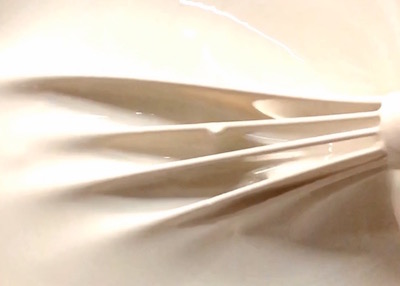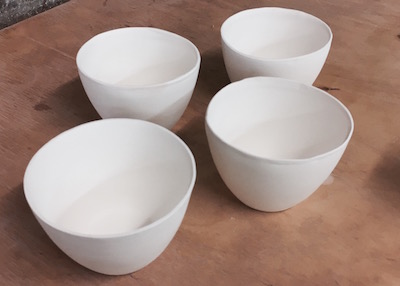 I’d like to share a bit about the method I use to make my pieces. The method is known as “slip casting” and involves casting pieces using a mould and liquid clay. Slip casting is very useful for making identical pieces. It is also a great method for reproducing pieces with more complex shapes and textures.
I’d like to share a bit about the method I use to make my pieces. The method is known as “slip casting” and involves casting pieces using a mould and liquid clay. Slip casting is very useful for making identical pieces. It is also a great method for reproducing pieces with more complex shapes and textures.
To make a piece using the slip casting method you will need a model in clay, plaster, or any medium which holds a form and has a non-porous surface. I personally prefer using plaster, which is quicker to work with and can be shaped more precisely compared to clay.
 You can base your model on an existing item (random things you can find at home often make good base shapes) and then customise it. If you want to make a model from scratch and have access to a pottery wheel, you can use the wheel to form a round shape out of a lump of plaster. The plaster needs to be freshly made and not yet hardened. Once you have a model, you can make a plaster mould from it (mould making deserves its own journal post, so I will be writing one soon). If you are using clay rather than plaster to make your model, make sure that the clay is dry and there are no pores on the surface before making the mould.
You can base your model on an existing item (random things you can find at home often make good base shapes) and then customise it. If you want to make a model from scratch and have access to a pottery wheel, you can use the wheel to form a round shape out of a lump of plaster. The plaster needs to be freshly made and not yet hardened. Once you have a model, you can make a plaster mould from it (mould making deserves its own journal post, so I will be writing one soon). If you are using clay rather than plaster to make your model, make sure that the clay is dry and there are no pores on the surface before making the mould.
Once the plaster mould is dry and ready to work with, pour some liquid clay called ”casting slip” into it. Make sure that the slip has a nice consistency by pouring through a sieve when you pour it in. The idea is that the mould will absorb the moisture from the casting slip, forming a dry layer of clay on the inside of the mould. Waiting longer will result in a thicker, heavier piece, so I recommend using a timer.
 Once the clay has reached the thickness you want, pour out excesses slip and leave the mould upside down to dry the piece evenly. Once the clay gets leather hard, cut off the excess clay around the entry of the mould. Wait until the piece is dry to safely take it out from the mould.
Once the clay has reached the thickness you want, pour out excesses slip and leave the mould upside down to dry the piece evenly. Once the clay gets leather hard, cut off the excess clay around the entry of the mould. Wait until the piece is dry to safely take it out from the mould.
Trim the edges of the rim and wait until the piece is bone dry. Bisque fire the piece and sand it if needed. Lastly, apply a glaze and fire the piece again.
 That’s it! It may seem like a lot, but once you have a mould, the production process can be quicker and more consistent compared to other methods. You will easily be able to make identical pieces without spending much time giving them their shape. Although, you can still make each of your pieces different if you want by giving them a unique finish.
That’s it! It may seem like a lot, but once you have a mould, the production process can be quicker and more consistent compared to other methods. You will easily be able to make identical pieces without spending much time giving them their shape. Although, you can still make each of your pieces different if you want by giving them a unique finish.